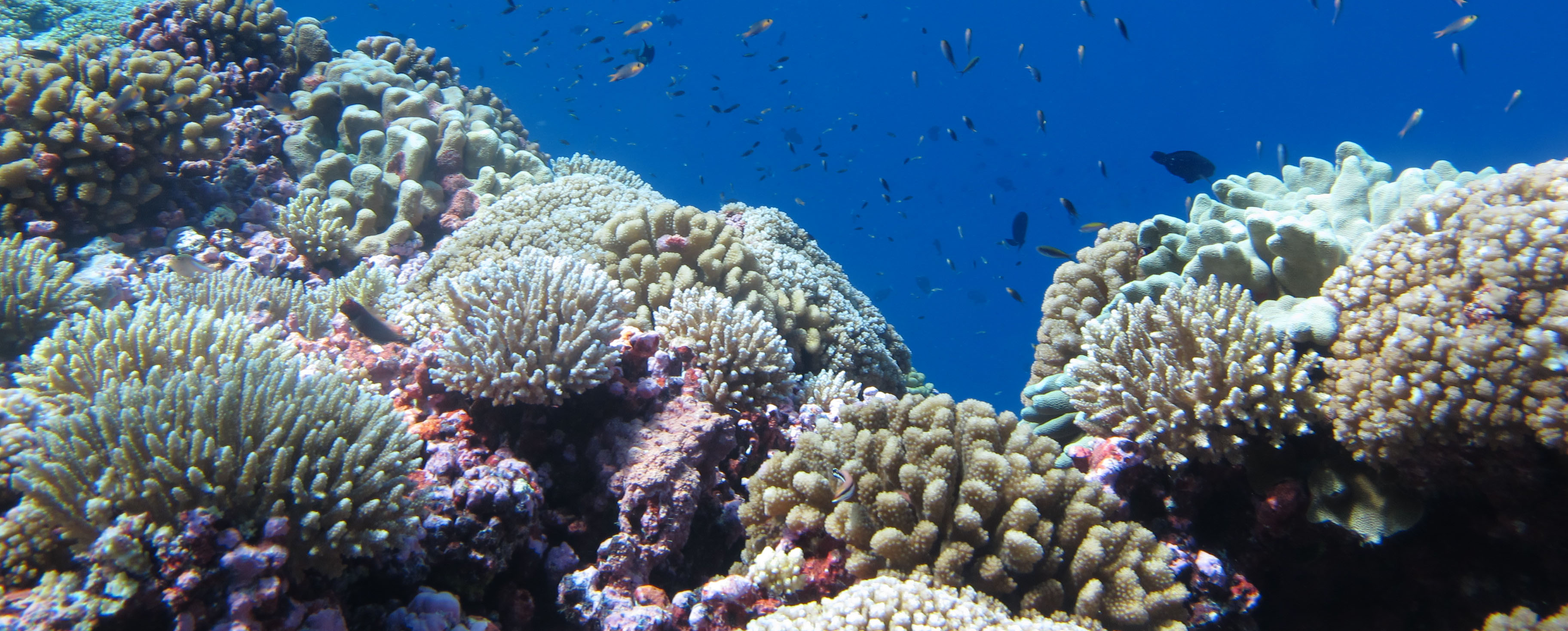Global S&T Development Trend Analysis Platform of Resources and Environment
| Scientists Find that Corals Rely More on Hunting than Previously Thought | |
| admin | |
| 2019-09-24 | |
| 发布年 | 2019 |
| 语种 | 英语 |
| 国家 | 美国 |
| 领域 | 资源环境 |
| 正文(英文) |  A coral reef in the Central Pacific. PC: Mike Fox A new study from researchers at Scripps Institution of Oceanography at UC San Diego, Woods Hole Oceanographic Institution (WHOI), and the University of New Mexico is revealing that more of corals’ nutrients come from hunting than previously expected, information that may help predict the fate of coral reefs as global ocean temperatures rise. The study published Tuesday, September 17, in the journal Functional Ecology. When it comes to feeding, corals have two options. Most of their nutrients come from microscopic algae living inside of them, but if those algae aren’t creating enough sustenance, corals can use their tentacles to grab and eat prey swimming nearby. Paper lead author Mike Fox – a postdoctoral scholar at WHOI who completed this research as a PhD student at Scripps – found that some corals rely more on hunting than scientists previously suspected. Fox and colleagues conducted their study using samples they collected at Palmyra Atoll, a U.S. National Wildlife Refuge in the central Pacific Ocean. After bringing them back into the lab, the researchers removed the coral polyps from their skeletons, and then separated the coral animals and their symbiotic algae in a centrifuge. The team then extracted essential amino acids from the corals, algae, and the tiny zooplankton that corals often eat. “Essential amino acids are required for an animal to survive, but most corals can’t make them. They have to get them from either their symbionts or something they just ate,” said Fox. “But each of those sources make amino acids in different ways, which gives the molecules distinct chemical signatures.” Those signatures can be used to fingerprint the source of the amino acid. By measuring chemical differences in six individual amino acids, the researchers were able to determine how much of a coral’s nutrition was coming from symbionts, or from captured prey. This new method for measuring coral nutrition allows scientists to estimate the contributions of different food sources to coral diets, providing a more accurate view of their nutrition than previous methods. The idea to apply this technique to reef-building corals was co-developed by Fox and Seth Newsome of the University of New Mexico, who is a co-author on the study. “To my knowledge, this has never been done with corals before. It really changed our perspective,” says Fox. “Our findings suggest that some corals are eating a lot more than we previously thought, which has big implications for reef survival during climate change. We’ve also learned that individual corals of the same species can have very different diets—this may be an important source of variation that we’ll have to take into account to understand how corals will respond to future changes.” Coral bleaching is triggered by warmer than average water temperatures. Symbiotic algae, which live inside corals and provide them with most of their nutrients, are expelled from their body. If corals stay bleached for too long they starve to death, but if a coral has the opportunity to eat a substantial amount before it bleaches or while it is bleached, it can survive off its fat stores long enough to regain those symbionts when water temperatures cool down. “If we can better understand when, where, or why corals are eating, we may be able to understand why they survive better in some places than others during future bleaching events, said Fox. “This new fingerprinting approach will likely transform our ability to learn about coral nutrition and diet at a time where this information is critical to predicting how corals will respond to future warm water events,” said Jennifer Smith, Mike Fox’s PhD advisor at Scripps and a paper co-author. Also collaborating on the paper was Emma A. Elliott Smith of the University of New Mexico..The research was conducted under special use permits #12533-14016 and #12533-14012 from the U.S. Fish and Wildlife Service, Palmyra Atoll Research Consortium (PARC). Funding was provided by the Scripps Family Foundation, private donors, and the NOAA Nancy Foster Scholarship. This story was adapted from Woods Hole Oceanographic Institution. |
| URL | 查看原文 |
| 来源平台 | Scripps Institution of Oceanography |
| 文献类型 | 新闻 |
| 条目标识符 | http://119.78.100.173/C666/handle/2XK7JSWQ/216628 |
| 专题 | 资源环境科学 |
| 推荐引用方式 GB/T 7714 | admin. Scientists Find that Corals Rely More on Hunting than Previously Thought. 2019. |
| 条目包含的文件 | 条目无相关文件。 | |||||
| 个性服务 |
| 推荐该条目 |
| 保存到收藏夹 |
| 查看访问统计 |
| 导出为Endnote文件 |
| 谷歌学术 |
| 谷歌学术中相似的文章 |
| [admin]的文章 |
| 百度学术 |
| 百度学术中相似的文章 |
| [admin]的文章 |
| 必应学术 |
| 必应学术中相似的文章 |
| [admin]的文章 |
| 相关权益政策 |
| 暂无数据 |
| 收藏/分享 |
除非特别说明,本系统中所有内容都受版权保护,并保留所有权利。
修改评论